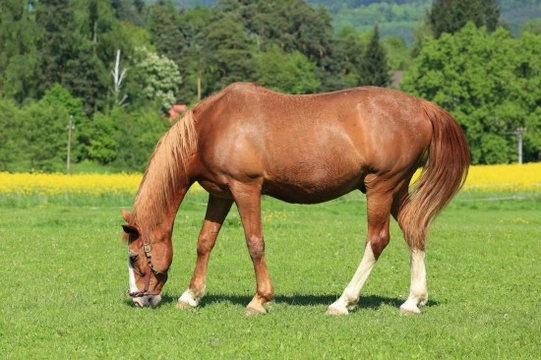
Sweet itch in horses
Sweet itch is an irritating and sometimes painful condition that a significant proportion of horses, ponies and donkeys will fall prey to during the hotter months of the year. Theoretically any breed or type of equine can fall prey to sweet itch, although it tends to be more prevalent in cob types than in Arabs, thoroughbreds and other warm-blooded non-native breeds. It is an allergic condition, and can cause extreme irritation and itchiness, and distress due to scratching and rubbing the affected areas of skin. Left unchecked, secondary infections can occur, due to sores and grazes that are raised by scratching to distraction.
What causes sweet itch?
Sweet itch is an allergic condition that comes about when the horse (or pony or donkey) in question is allergic to the saliva of the Culicoides midge. These midges occur naturally in many countries of the world, including the UK, and most horses are unaffected by the bite and will not present with an allergic reaction. Several potentially allergenic compounds are found in the saliva of the midge, and it is not known precisely which compound causes the reaction, or if it might vary from case to case.
The symptoms of sweet itch
Sweet itch is generally only seen when midges are out in significant numbers, such as in the spring and summer and sometimes, into the autumn. Winter attacks of sweet itch are relatively rare. The most common location for the allergic reaction to present itself is along the crest of the mane and the top of the tail, with secondary patches along the spine and around the head and ears, although sweet itch can ultimately present itself on any area of the body.
The bites of the midges themselves will be invisible, but sweet itch can be identified by the development of skin lesions in the affected areas, which are caused by the extreme itchiness caused by the bites leading to the horse scratching itself until they break the skin. Be on the lookout for bald patches or broken hairs, and grazed, broken skin or weeping sores.
Preventing sweet itch
It is almost impossible to reverse an allergic reaction once a horse has been bitten, and so the best course of action to follow in horses that are prone to sweet itch is to prevent or minimise the chances of the midges biting in the first place.
- Insect repellents can be helpful, but these must be applied and refreshed regularly in order to prove effective. Either natural products such as citronella, or compound pesticides such as are found in commercially produced equine fly repellents can be used.
- Midges thrive around still and stagnant water, so try not to graze your horse in boggy or particularly wet fields, or on land that has a pond or stagnant lake that attracts midges.
- Barriers to midges and other biting insects such as fly sheets, fly masks and screens for the stable door can help too.
- Some owners use a range of nutritional supplements to help either discourage the midge from biting or to boost the immune system, such as linseed oil. However, no empirical research has been conducted as to the efficacy of supplements to aid with sweet itch.
- Midges are most active in the evenings between around 4pm and 9pm. Stabling your horse during these hours can help to reduce the severity of an attack, or prevent it altogether.
- Midges are also only found in great numbers on still days, and cannot remain airborne in winds above 5mph. You will usually find that your horse is worst affected on still days, and will be comfortable and midge-free in blustery weather!
Treating sweet itch
Once sweet itch has begun to manifest itself in a sensitive horse or pony, treating an attack can prove difficult, and no cure is available. Trying to avoid worsening the problem with further attacks by means of the preventative methods outlined above is recommended. Treatment options for an attack include:
- Controlling the symptoms with antihistamine creams to help reduce itching and irritation, but this can prove expensive in the long run.
- In severe cases, corticosteroids may be required in order to control an attack. Corticosteroids may be the only option in severe attacks, but these are not without complications of their own, so this is not a course of treatment to undertake lightly.
- Antibiotics may be given to treat any secondary infection or complication from infected sores.
- Natural products such as lavender, chamomile or tea-tree oil shampoos or preparations may be used to calm down irritation.
- Immunotherapy and desensitisation therapy is a recent treatment method that some veterinary surgeons advocate, which involves manipulating the body’s immuno-response patterns in order to “train” the body away from reacting to the potential allergen. This treatment method is currently still considered to be experimental, and may not be appropriate for all horses.



